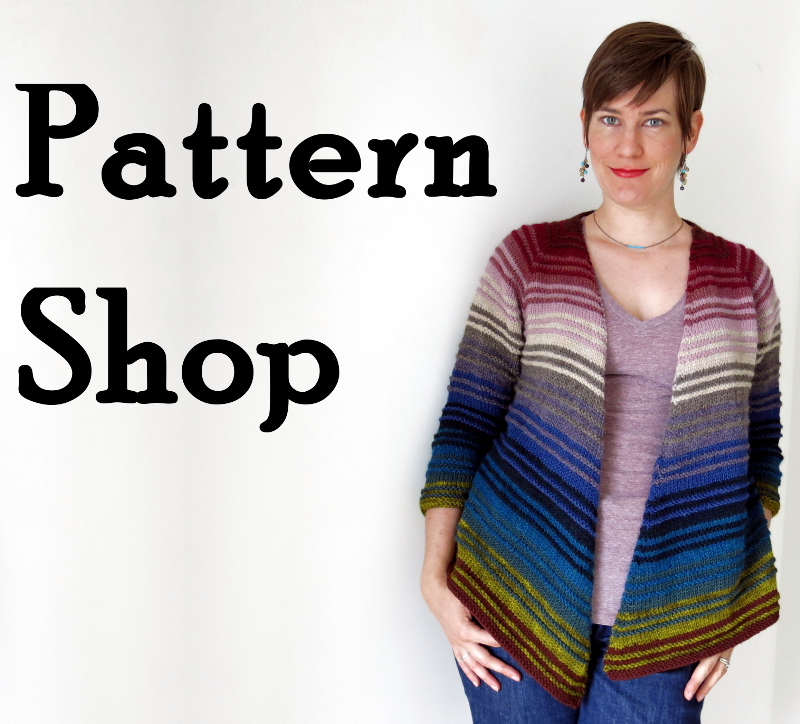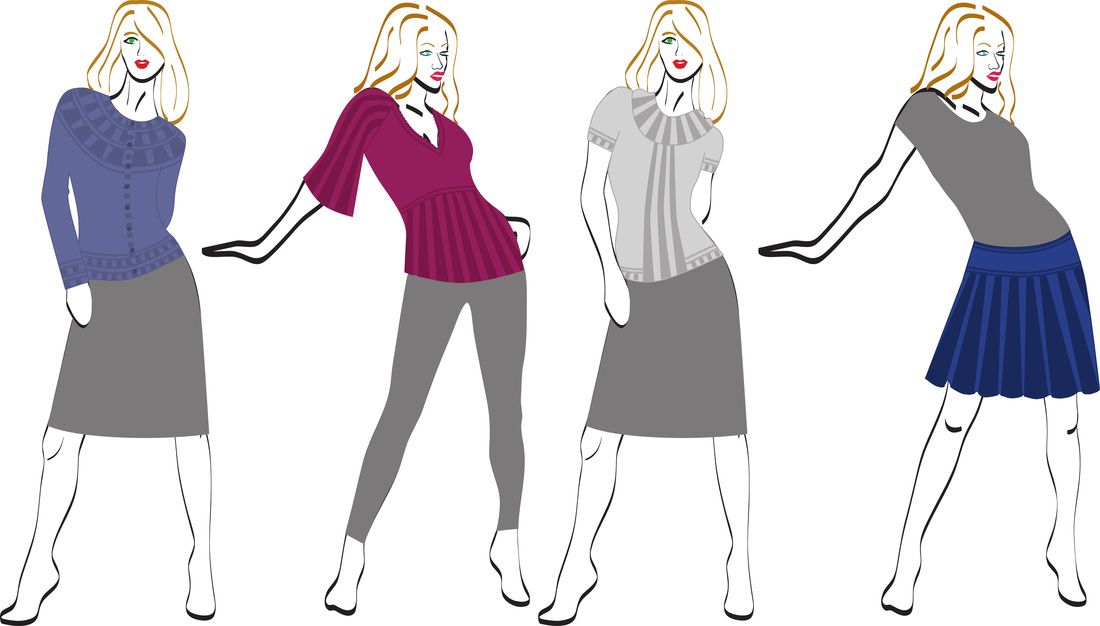Size
Since we are in the age of the internet, anyone who makes one of my patterns can easily contact me, and lately I have received lots of emails about which size in a pattern to choose. Now, I try my best to help, but since I don't know you, how you like to wear your clothes, or what your body type is, all I can do is help you choose a size based on the information you give me. Sometimes my advice is appreciated, and sometimes it's not. But simply telling me your bust and waist measurements isn't really going to cut it. I would like to encourage all knitters to know their body types, how tight or loose they like to wear their clothes, and know their own measurements. The schematic in a pattern is not simply for blocking; it should be used to help you choose the best size for yourself. Choosing a size by the bust measurement only is not the best method. It is the easiest, but in no way doesn't it guarantee a good fit.
Interweave Knits and Knitscene usually try to help by noting which size the model is wearing and with how much ease. But really, the most important measurement for choosing a size is the shoulder width. Why? Because to look right, a set-in sleeve shoulder seam needs to rest on your shoulder bone to look good. The bust, waist and hip measurements can be altered much more easily than the shoulder width- because, when you change the shoulders you have to start changing the sleeve cap math and that gets really complicated very quickly.
So once you measure your shoulder width and determine the best size, don't just stop there and start knitting. Check the other measurements as well to see if you need to make any adjustments. Designers work off a chart of 'standard measurements' but not everyone fits into those standards, and you will do yourself a favor if you know how your body differs from those standards. Check the armhole length: is it too long or too short? Check the body length as well, you might like your sweaters to be longer or shorter than the pattern. Check the bust, waist and hip circumferences too. Yes, you might need to do some math to make alterations. No, it isn't fun. Do you want a sweater that fits well? Yes? Then the math is necessary. The book 'Knit To Flatter' by Amy Herzog is a really good tool that explains fit, different body types, and how to modify patterns to fit your shape, and I encourage all knitters to read it.
Yarn Choice
When designers create a pattern in a certain type of yarn, they take the properties of that yarn into account in the pattern. If a pattern was designed with a wool yarn, using a cotton yarn may not be the best idea because wool and cotton have very different properties. Wool is (usually) very elastic and bouncy. Cotton is inelastic, can stretch out easily, and can get very heavy. When I work with cotton yarns, I try to use seams to add stability, otherwise the sweater would get all stretched out as it is being worn. A couple days ago I saw a project note that said the knitter was going to modify the pattern to get rid of the shoulder seams because she didn't like seaming, and I wanted to yell "No! No! You need those!!!" The weight of the sweater hangs off the shoulder seams, and you need those seams to provide stability to keep the whole thing from drooping. Then today I saw someone is making a sweater out of pure silk yarn. AAAHHHH!!!! Silk stretches out like the Dickens and doesn't bounce back!!! Please, research your fiber choice. Another good book is "The Knitters Book of Yarn" by Clara Parkes, and it explains all the different properties of various fibers. If you don't want to do that, at least when choosing a yarn stick with the same type of fiber as the original design.
Also related to yarn choice is the yarn weight. Every once in awhile I get an email saying "Hey I love your x pattern, but it uses worsted weight and I want to use up this DK weight in my stash so can you re-write the pattern for me?" Ummm.. no. That would involve a couple hours of math and a spreadsheet, and while I'm thrilled that you want to make my pattern, I'm not going to do all that math for free. Then, inevitably, after I make my polite reply I get one of two questions in return. Either "Can't I just use bigger/smaller needles to get the same gauge?" or "Can't I just knit a bigger/smaller size to accommodate?" Using bigger or smaller needles could give you holey fabric or something that could be a substitute for Kevlar, and I wouldn't recommend it. Knitting a bigger or smaller size might negatively affect the length, and a sweater with armholes that cuts off the circulation of blood in your arms simply won't be worn. I try to carefully word my reply that, while either of those might work I can't guarantee the results and you might not be happy with how it turns out. There isn't really an easy way around it, so unless you want to figure out the new gauge and calculate all new measurements based off the schematic, you will probably want to stick with the same weight yarn that the pattern calls for.
What this all boils down to is knitting education and fear. I think some knitters just want to blindly follow the pattern without learning anything. Years ago a knitter was showing me a hat she made, and it looked a bit... funny. She said there was some stitch in the pattern that she didn't know how to do, so she just skipped it! Uhhh... yeah, that's not really a solution. So I know it might sound like 'work', but try to expand your knitting knowledge. Learn new techniques, try to make a better fit on a sweater, and if it doesn't turn out right you can rip back and start again. Don't feel like a failure if you have to rip back. For every project I make, I have to rip back at least once. It's a drag, but you know what? When I rework it, I'm happy with the new changes every time.





 RSS Feed
RSS Feed
